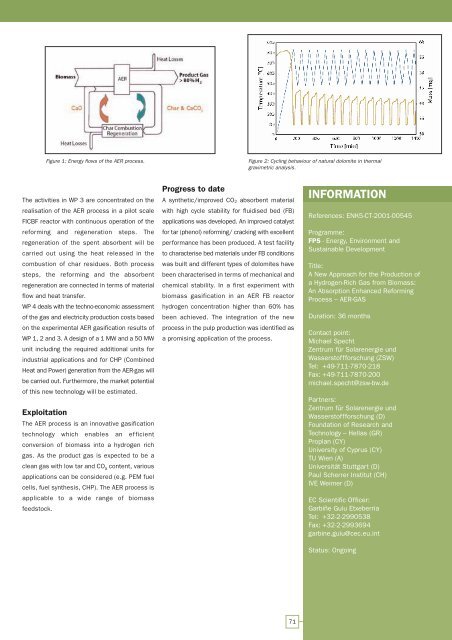European Bio-Energy Projects
European Bio-Energy Projects
European Bio-Energy Projects
You also want an ePaper? Increase the reach of your titles
YUMPU automatically turns print PDFs into web optimized ePapers that Google loves.
Figure 1: <strong>Energy</strong> flows of the AER process.<br />
The activities in WP 3 are concentrated on the<br />
realisation of the AER process in a pilot scale<br />
FICBF reactor with continuous operation of the<br />
reforming and regeneration steps. The<br />
regeneration of the spent absorbent will be<br />
carried out using the heat released in the<br />
combustion of char residues. Both process<br />
steps, the reforming and the absorbent<br />
regeneration are connected in terms of material<br />
flow and heat transfer.<br />
WP 4 deals with the techno-economic assessment<br />
of the gas and electricity production costs based<br />
on the experimental AER gasification results of<br />
WP 1, 2 and 3. A design of a 1 MW and a 50 MW<br />
unit including the required additional units for<br />
industrial applications and for CHP (Combined<br />
Heat and Power) generation from the AER-gas will<br />
be carried out. Furthermore, the market potential<br />
of this new technology will be estimated.<br />
Exploitation<br />
The AER process is an innovative gasification<br />
technology which enables an efficient<br />
conversion of biomass into a hydrogen rich<br />
gas. As the product gas is expected to be a<br />
clean gas with low tar and COx content, various<br />
applications can be considered (e.g. PEM fuel<br />
cells, fuel synthesis, CHP). The AER process is<br />
applicable to a wide range of biomass<br />
feedstock.<br />
Progress to date<br />
A synthetic/improved CO2 absorbent material<br />
with high cycle stability for fluidised bed (FB)<br />
applications was developed. An improved catalyst<br />
for tar (phenol) reforming/ cracking with excellent<br />
performance has been produced. A test facility<br />
to characterise bed materials under FB conditions<br />
was built and different types of dolomites have<br />
been characterised in terms of mechanical and<br />
chemical stability. In a first experiment with<br />
biomass gasification in an AER FB reactor<br />
hydrogen concentration higher than 60% has<br />
been achieved. The integration of the new<br />
process in the pulp production was identified as<br />
a promising application of the process.<br />
Figure 2: Cycling behaviour of natural dolomite in thermal<br />
gravimetric analysis.<br />
71<br />
INFORMATION<br />
References: ENK5-CT-2001-00545<br />
Programme:<br />
FP5 - <strong>Energy</strong>, Environment and<br />
Sustainable Development<br />
Title:<br />
A New Approach for the Production of<br />
a Hydrogen-Rich Gas from <strong>Bio</strong>mass:<br />
An Absorption Enhanced Reforming<br />
Process – AER-GAS<br />
Duration: 36 months<br />
Contact point:<br />
Michael Specht<br />
Zentrum für Solarenergie und<br />
Wasserstoffforschung (ZSW)<br />
Tel: +49-711-7870-218<br />
Fax: +49-711-7870-200<br />
michael.specht@zsw-bw.de<br />
Partners:<br />
Zentrum für Solarenergie und<br />
Wasserstoffforschung (D)<br />
Foundation of Research and<br />
Technology – Hellas (GR)<br />
Proplan (CY)<br />
University of Cyprus (CY)<br />
TU Wien (A)<br />
Universität Stuttgart (D)<br />
Paul Scherrer Institut (CH)<br />
IVE Weimer (D)<br />
EC Scientific Officer:<br />
Garbiñe Guiu Etxeberria<br />
Tel: +32-2-2990538<br />
Fax: +32-2-2993694<br />
garbine.guiu@cec.eu.int<br />
Status: Ongoing

















